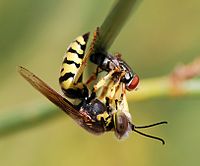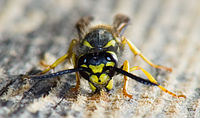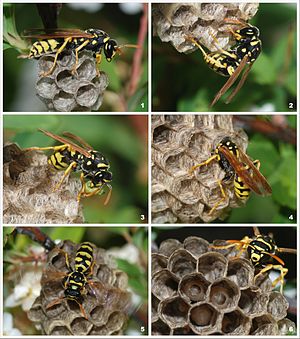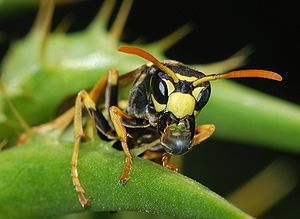
Wasp
Did you know...
SOS Children offer a complete download of this selection for schools for use on schools intranets. Before you decide about sponsoring a child, why not learn about different sponsorship charities first?
| Wasps | |
|---|---|
 |
|
| Aleiodes indiscretus parasitizing a gypsy moth caterpillar |
|
| Scientific classification | |
| Kingdom: | Animalia |
| Phylum: | Arthropoda |
| Class: | Insecta |
| Order: | Hymenoptera |
| Suborder | |
|
Apocrita |
|
A wasp is any insect of the order Hymenoptera and suborder Apocrita that is neither bee nor ant. The suborder Symphyta includes the sawflies and wood wasps, which differ from members of Apocrita by having a broader connection between the mesosoma and metasoma. In addition to this, Symphyta larvae are mostly herbivorous and " caterpillarlike", whereas those of Apocrita are largely predatory or "parasitic" (technically known as parasitoid).
The most familiar wasps belong to Aculeata, a division of Apocrita, whose ovipositors are adapted into a venomous stinger. Aculeata also contains ants and bees. In this respect, insects called "velvet ants" (the family Mutillidae) are technically wasps.
A much narrower and simpler but popular definition of the term wasp is any member of the Aculeate family Vespidae, which includes (among others) the genera known in North America as yellowjackets (Vespula and Dolichovespula) and hornets (Vespa).
Categorization
The various species of wasp fall into one of two main categories: solitary wasps and social wasps. Adult solitary wasps generally live and operate alone, and most do not construct nests; all adult solitary wasps are fertile. By contrast, social wasps exist in colonies numbering up to several thousand strong and build nests—but in some cases not all of the colony can reproduce. Generally, just the wasp queen and male wasps can mate, whilst the majority of the colonies are made up of sterile female workers.
Characteristics
The following characteristics are present in most wasps:
- two pairs of wings (except wingless or brachypterous forms in all female Mutillidae, Bradynobaenidae, many male Agaonidae, many female Ichneumonidae, Braconidae, Tiphiidae, Scelionidae, Rhopalosomatidae, Eupelmidae, and various other families).
- An ovipositor, or stinger (which is only present in females because it derives from the ovipositor, a female sex organ).
- Few or no hairs (in contrast to bees); except Mutillidae, Bradynobaenidae, Scoliidae.
- Nearly all wasps are terrestrial; only a few specialized parasitic groups are aquatic.
- Predators or parasitoids, mostly on other terrestrial insects; some species of Pompilidae, such as the tarantula hawk, specialize in using spiders as prey, and various parasitic wasps use spiders or other arachnids as reproductive hosts.
Wasps are critically important in natural biocontrol. Almost every pest insect species has a wasp species that is a predator or parasite upon it. Parasitic wasps are also increasingly used in agricultural pest control as they have little impact on crops. Wasps also constitute an important part of the food chain.
Biology
Genetics
In wasps, as in other Hymenoptera, sexes are significantly genetically different. Females have a diploid (2n) number of chromosomes and come about from fertilized eggs. Males, in contrast, have a haploid (n) number of chromosomes and develop from an unfertilized egg. Wasps store sperm inside their body and control its release for each individual egg as it is laid; if a female wishes to produce a male egg, she simply lays the egg without fertilizing it. Therefore, under most conditions in most species, wasps have complete voluntary control over the sex of their offspring.
Anatomy and gender

Anatomically, there is a great deal of variation between different species of wasp. Like all insects, wasps have a hard exoskeleton covering their 3 main body parts. These parts are known as the head, metasoma and mesosoma. Wasps also have a constricted region joining the first and second segments of the abdomen (the first segment is part of the mesosoma, the second is part of the metasoma) known as the petiole. Like all insects, wasps have 3 sets of 2 legs. In addition to their compound eyes, wasps also have several simple eyes known as ocelli. These are typically arranged in a triangular formation just forward of an area of the head known as the vertex.
It is possible to distinguish between certain wasp species genders based on the number of divisions on their antennae. Male Yellowjacket wasps for example have 13 divisions per antenna, while females have 12. Males can in some cases be differentiated from females by virtue of the fact that the upper region of the male's mesosoma(called the tergum) consists of an additional terga. The total number of terga is typically 6. The difference between sterile female worker wasps and queens also varies between species but generally the queen is noticeably larger than both males and other females.
Wasps can be differentiated from bees as bees have a flattened hind basitarsus. Unlike bees, wasps generally lack plumose hairs. They vary in the number and size of hairs they have between species.
Diet
Generally wasps are parasites or parasitoids as larvae, and feed only on nectar as adults. Many wasps are predatory, using other insects (often paralyzed) as food for their larvae. A few social wasps are omnivorous, feeding on a variety of fallen fruit, nectar, and carrion. Some of these social wasps, such as yellowjackets, may scavenge for dead insects to provide for their young. In many social species the larvae provide sweet secretions that are fed to the adults.
In parasitic species, the first meals are almost always provided by the animal that the adult wasp used as a host for its young. Adult male wasps sometimes visit flowers to obtain nectar to feed on in much the same manner as honey bees. Occasionally, some species, such as yellowjackets, invade honey bee nests and steal honey and/or brood.
Wasp parasitism
With most species, adult parasitic wasps themselves do not take any nutrients from their prey, and, much like bees, butterflies, and moths, they typically derive all of their nutrition from nectar. Parasitic wasps are typically parasitoids, and extremely diverse in habits, many laying their eggs in inert stages of their host ( egg or pupa), or sometimes paralyzing their prey by injecting it with venom through their ovipositor. They then insert one or more eggs into the host or deposit them upon the host externally. The host remains alive until the parasitoid larvae are mature, usually dying either when the parasitoids pupate, or when they emerge as adults.
Nesting habits
The type of nest produced by wasps can depend on the species and location. Many social wasps produce paper pulp nests on trees, in attics, holes in the ground or other such sheltered areas with access to the outdoors. By contrast solitary wasps are generally parasitic or predatory and only the latter build nests at all. Unlike honey bees, wasps have no wax producing glands. Many instead create a paper-like substance primarily from wood pulp. Wood fibers are gathered locally from weathered wood, softened by chewing and mixing with saliva. The pulp is then used to make combs with cells for brood rearing. More commonly, nests are simply burrows excavated in a substrate (usually the soil, but also plant stems), or, if constructed, they are constructed from mud.
Solitary wasps
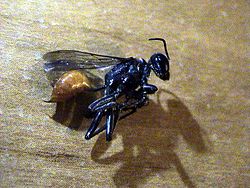
The nesting habits of solitary wasps are more diverse than those of social wasps. Mud daubers and pollen wasps construct mud cells in sheltered places typically on the side of walls. Potter wasps similarly build vase-like nests from mud, often with multiple cells, attached to the twigs of trees or against walls. Most other predatory wasps burrow into soil or into plant stems, and a few do not build nests at all and prefer naturally occurring cavities, such as small holes in wood. A single egg is laid in each cell, which is sealed thereafter, so there is no interaction between the larvae and the adults, unlike in social wasps. In some species, male eggs are selectively placed on smaller prey, leading to males being generally smaller than females.
Social wasps
The nests of some social wasps, such as hornets, are first constructed by the queen and reach about the size of a walnut before sterile female workers take over construction. The queen initially starts the nest by making a single layer or canopy and working outwards until she reaches the edges of the cavity. Beneath the canopy she constructs a stalk to which she can attach several cells; these cells are where the first eggs will be laid. The queen then continues to work outwards to the edges of the cavity after which she adds another tier. This process is repeated, each time adding a new tier until eventually enough female workers have been born and matured to take over construction of the nest leaving the queen to focus on reproduction. For this reason, the size of a nest is generally a good indicator of approximately how many female workers there are in the colony. Social wasp colonies often have populations exceeding several thousand female workers and at least one queen. Polistes and some related types of paper wasp do not construct their nests in tiers but rather in flat single combs.
Social wasp reproductive cycle ( temperate species only)
Wasps do not reproduce via mating flights like bees. Instead social wasps reproduce between a fertile queen and male wasp; in some cases queens may be fertilized by the sperm of several males. After successfully mating, the male's sperm cells are stored in a tightly packed ball inside the queen. The sperm cells are kept stored in a dormant state until they are needed the following spring. At a certain time of the year (often around autumn), the bulk of the wasp colony dies away, leaving only the young mated queens alive. During this time they leave the nest and find a suitable area to hibernate for the winter.
First stage
After emerging from hibernation during early spring, the young queens search for a suitable nesting site. Upon finding an area for their future colony, the queen constructs a basic paper fibre nest roughly the size of a walnut into which she will begin to lay eggs.
Second stage
The sperm that was stored earlier and kept dormant over winter is now used to fertilize the eggs being laid. The storage of sperm inside the female queen allows her to lay a considerable number of fertilized eggs without the need for repeated mating with a male wasp. For this reason a single female queen is capable of building an entire colony from only herself. The queen initially raises the first several sets of wasp eggs until enough sterile female workers exist to maintain the offspring without her assistance. All of the eggs produced at this time are sterile female workers who will begin to construct a more elaborate nest around their queen as they grow in number.
Third stage
By this time the nest size has expanded considerably and now numbers between several hundred and several thousand wasps. Towards the end of the summer, the queen begins to run out of stored sperm to fertilize more eggs. These eggs develop into fertile males and fertile female queens. The male drones then fly out of the nest and find a mate thus perpetuating the wasp reproductive cycle. In most species of social wasp the young queens mate in the vicinity of their home nest and do not travel like their male counterparts do. The young queens will then leave the colony to hibernate for the winter once the other worker wasps and founder queen have started to die off. After successfully mating with a young queen, the male drones die off as well. Generally, young queens and drones from the same nest do not mate with each other; this ensures more genetic variation within wasp populations, especially considering that all members of the colony are theoretically the direct genetic descendants of the founder queen and a single male drone. In practice, however, colonies can sometimes consist of the offspring of several male drones. Wasp queens generally (but not always) create new nests each year, probably because the weak construction of most nests render them uninhabitable after the winter.
Unlike most honey bee queens, wasp queens typically live for only one year (although exceptions are possible). Also, contrary to popular belief queen wasps do not organize their colony or have any raised status and hierarchical power within the social structure. They are more simply the reproductive element of the colony and the initial builder of the nest in those species which construct nests.
Social wasp caste structure
Not all social wasps have castes that are physically different in size and structure. In many polistine paper wasps and stenogastrines, for example, the castes of females are determined behaviorally, through dominance interactions, rather than having caste predetermined. All female wasps are potentially capable of becoming a colony's queen and this process is often determined by which female successfully lays eggs first and begins construction of the nest. Evidence suggests that females compete amongst each other by eating the eggs of other rival females. The queen may, in some cases, simply be the female that can eat the largest volume of eggs while ensuring that her own eggs survive (often achieved by laying the most). This process theoretically determines the strongest and most reproductively capable female and selects her as the queen. Once the first eggs have hatched, the subordinate females stop laying eggs and instead forage for the new queen and feed the young; that is, the competition largely ends, with the losers becoming workers, though if the dominant female dies, a new hierarchy may be established with a former "worker" acting as the replacement queen. Polistine nests are considerably smaller than many other social wasp nests, typically housing only around 250 wasps, compared to the several thousand common with yellowjackets, and stenogastrines have the smallest colonies of all, rarely with more than a dozen wasps in a mature colony.
Common families
- Agaonidae - fig wasps
- Chalcididae
- Chrysididae - cuckoo wasps
- Crabronidae - sand wasps and relatives, e.g. the Cicada killer wasp
- Cynipidae - gall wasps
- Encyrtidae
- Eulophidae
- Eupelmidae
- Ichneumonidae, and Braconidae
- Mutillidae - velvet ants
- Mymaridae - fairyflies
- Pompilidae - spider wasps
- Pteromalidae
- Scelionidae
- Scoliidae - scoliid wasps
- Sphecidae - digger wasps
- Tiphiidae - flower wasps
- Torymidae
- Trichogrammatidae
- Vespidae - yellowjackets, hornets, paper wasps (umbrella), potter wasps, pollen wasps



